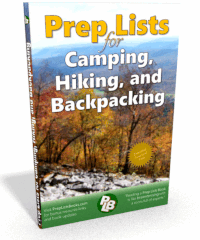A section in Chapter 1 of the book:
Prep Lists for Camping, Hiking, and Backpacking
Fire Building Methods
Before you start building your fire, you should decide which type of fire lay you need, given your conditions and use of the fire.
- Teepee (or Tipi): Quick, easy, flexible, focused heat
- Log Cabin: Stable, burns more slowly, provides better coals
- Top-Down Log Cabin (Council Fire, Top-Lighter): Burns very slowly with minimal maintenance
- Lean-To: Best accommodating for wind and awkward fuel
- Hunter’s: Built between two parallel logs provides better wind control and an easy platform for pots & pans
- Dakota Fire Pit: Built underground in one end of a U-shaped tunnel, the controlled air flow make this very hot, well-contained, and easy to arrange a pot or pan.
- Hybrid: Combining variations of any of the above
- Finnish: Stacked logs for very long burns
- Keyhole: Combining a larger/circular area for the fire, and a smaller/rectangular area for dragging hot coals for cooking
- Star (Indian): Burning the ends or middles of long logs (like the spokes of a wheel) and rearranging them as they burn through—into shorter logs
A One-Stick Fire
After a heavy rain, most natural materials will be too wet to make a fire—unless you expose the dry wood inside logs and branches. Learn how to use a knife and a baton to create your own tinder (shavings), kindling (feather or fuzz sticks), and fuel (split wood) from a single stick of wood. Using this method eliminates the need for a heavy axe, a big saw, or any other equipment.
} } } This information is in the book “Prep Lists for Camping, Hiking, and Backpacking.” { { {


You must log in to post a comment. Log in now.